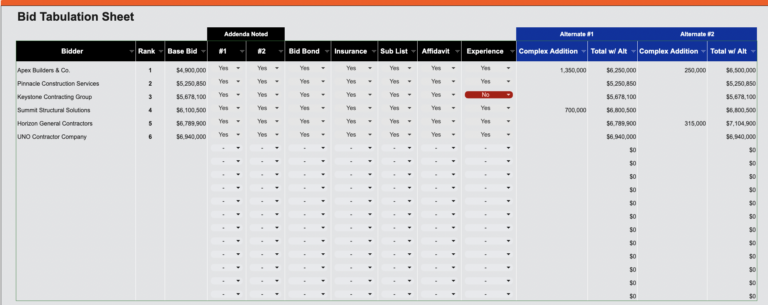— 6 min read
Bid Tabulation: Must-Have Criteria for Comparing Bids (With Free Template)
Last Updated Sep 5, 2024
Last Updated Sep 5, 2024

While construction is arguably one of the most tangible industries, many big pieces that drive a project’s success aren’t items people can put their hands on. Instead, they need to wrap their heads around specific aspects to make informed decisions well before groundbreaking.
Every project owner needs to choose a general contractor (GC) to manage the project, for example. To select the right partner, owners solicit bids, then evaluate them. The most important moment in this bidding process comes when it’s time to choose a bidder and award them the contract.
How do decision-makers do this in a fair and transparent way while also focusing on the best bidder for their requirements and preferences? Bid tabulation helps.
Table of contents
Building a Bid Tabulation Sheet
Bid tabulations compile the key details of all the submitted bids onto a table. This way, the project owner’s team can neatly review and compare bids.
Any good bid tabulation template will list each contractor on their own row, with columns for all of the criteria required on the project. The columns in the bid tab sheet need to match the requirements in the invitation to bid (ITB) that the owner sends out to solicit bids.
The key columns to include in a bid tabulation template include the following.
Base Price and Possible Alternate Pricing
The base bid price is the most important column in the bid tab sheet. This is the total that the contractor submitted for the project. In other words, it’s the result of their construction estimating.
In some cases, the base bid price might not be the only dollar-focused column. If the owner hasn’t yet pinned down the project, they may include two more columns: one for alternate pricing and one for the bid total with that alternate.
Say, for example, that an owner is considering adding a complex addition to the project and wants to get pricing information about that option. They can include that in their ITB as an alternate. The responding bidders would then submit their base bid price (for the project without the alternate) and their price for the alternate. By adding those two prices together in a third column, the owner can determine the total budget for the project should they decide to move forward with that alternate.
ITB Requirements
A strong bid tabulation document doesn’t just capture pricing information. It also lays out any other specifications required in the ITB, including:
- GC acknowledgment of any addenda that went out after the ITB to supplement or change it
- Signatures on any required affidavits
- The necessary insurance and bonding
- Any safety certifications, records, etc
- Bills of quantities, if required
- Confirmation of union labor or other specified labor force
Essentially, if the ITB asked for any documentation to prove that the GC is up to the project, the owner’s team should add a column to capture that in their bid tabulation sheet. If the project requires a specific welding certification, for example, the bid tab document should include a column where the owner’s team can check yes or no.
Ranking
Finally, the bid tabulation template should include a column in which the owner can rank the contractors.
Let’s say the owners’ team can see that three contractors came in with comparable pricing, but only one of them submitted all of the required paperwork in response to the bid. They can mark “1” in the ranking column for that contractor. This indicates that GC is the owner’s top choice.
A Bid Tabulation Template
What is a bid tabulation doing to make it easier for owners to choose the right general contractor? It compiles all of the details about the GC’s pricing and competency in one place in a structured and organized way. This helps to streamline the decision-making process.
Bid tab documents should change from project to project based on the unique specifications of that build. That said, starting with a bid tabulation template generally makes it easier to organize the details received in various bids.
Here is a basic template owners’ teams can use, tailoring it by adding or deleting the columns they need to appropriately evaluate contractors. The columns the owner’s team adds or deletes should be a direct reflection of what they asked for in the ITB.
Free Download
Bid Tab Template
Download this simple bid tab template and customize it for any project.
- Ready to use with custom data
- Reuse for multiple projects
- Trusted by construction professionals


Bid Tabulation on Public Projects
On a private project, the process for collecting and compiling bid information into a bid tabulation sheet usually happens behind closed doors. On a public project, though, the bid tab process is opened up to the bidders.
Generally, bids for public works are submitted in sealed envelopes. On the date on which the bids are due, everyone gathers in a room (in-person or virtually) as bids are unsealed and tabulated. The project owner’s team might use a whiteboard in the room or a shared screen in a virtual meeting to show their work as they go through each bid, mark down the base price, and check yes or no on any other requirements.
In other words, on a public project, the bid tabulation document is shared with the public. That means contractors can see where they fell among their competitors on the bid tab sheet.
Bid Tabulation vs. Bid Leveling
If all of this sounds a lot like bid leveling, it’s because it is. Both tabulation and leveling compile details about submitted bids in an effort to make them easier to compare.
What is a bid tabulation sheet doing differently than a bid leveling document, then? The biggest differentiator lies in their users. Owners primarily use bid tabulation to evaluate bids from GCs, while GCs often use bid leveling to analyze bids from specialty contractors. Because the GC needs to ensure that the complete scope of work is covered for each specialty trade, detailed bid leveling is often a more complex process, resulting in a more extensive comparison spreadsheet. Bid tabulation, by comparison, is generally simpler.
Stay updated on what’s happening in construction.
Subscribe to Blueprint, Procore’s free construction newsletter, to get content from industry experts delivered straight to your inbox.

Why Bid Tabulation Matters
Bid tabulation documents give owners a way to organize the information contractors submit in their bids so that they can choose the best partner for the project. These bid tabs deliver an efficient comparison tool to support informed decision-making.
Because bid tabulation ensures that contractors are all evaluated on the same criteria, it builds fairness into the process. It levels the playing field because the owner is considering facts and numbers when deciding who should be awarded the contract. As a result, it can help to limit the owner’s risk of disputes.
To best yield these benefits, owners need to create their bid tabulation sheet in a way that precisely mirrors the requirements they sent out in their invitation to bid. Whether they use a bid tabulation template or start from scratch, their team should go through the ITB piece by piece, capturing requirements in the bid tab document.
Was this article helpful?
Thank you for your submission.
100%
0%
You voted that this article was . Was this a mistake? If so, change your vote here.
Scroll less, learn more about construction.
Subscribe to The Blueprint, Procore’s construction newsletter, to get content from industry experts delivered straight to your inbox.
By clicking this button, you agree to our Privacy Notice and Terms of Service.
Categories:
Tags:
Written by
Ben Ashburn
20 articles
Ben Ashburn is a Senior Construction Education Trainer at Procore. After a successful career as a construction estimator — working his way up from estimating manager to senior estimator — Ben has spent the most recent part of his career in construction sharing his skills with other as a construction educator. Ben has an extensive background in construction education: He has been an assistant professor in the Department of Construction Science at Texas A&M, and lectured about estimating, scheduling, management, and other related construction topics at Murray State University. He has been a construction training and learning development partner with Procore since 2019.
View profileKacie Goff
54 articles
Kacie Goff is a construction writer who grew up in a construction family — her dad owned a concrete company. Over the last decade, she’s blended that experience with her writing expertise to create content for the Construction Progress Coalition, Newsweek, CNET, and others. She founded and runs her own agency, Jot Content, from her home in Ventura, California.
View profileExplore more helpful resources

Winning Bids with BIM: Marketing the Benefits to Owners
Creating a 3D model of a construction project is becoming more common but, that doesn’t mean that all projects leverage BIM – or, that all companies are using BIM in the...

Mastering Construction Bid Templates to Simplify the Process and Win More Work
Every construction project is different. Different set of challenges, timelines, key players, etc. Because every project is different, what project owners need to know from a bid will differ based...

How To Improve Your Bid-Hit Ratio: 5 Strategies To Deploy
The bidding process is a necessary part of the construction game for any general or specialty contractor. Without bidding jobs and getting awarded contracts, the company doesn’t have a way...

How Pre-Bid Meetings Impact Construction Bidding
Deciding to bid on construction jobs is not a decision contractors take lightly. There are many factors to consider in what constitutes the “right” project. Location, project type, available resources...